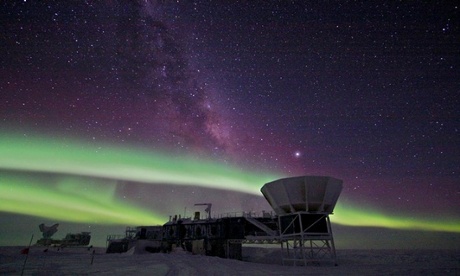It was hailed as one of the most important scientific discoveries of the century, the birth of a new era in physics and a shoo-in for a Nobel prize. The claim from Harvard University that it had discovered gravitational waves and thereby evidence for the theory of cosmic inflation and the existence of a multiverse caused a worldwide sensation in March. But the celebrations are now looking decidedly premature. Rather than securing a trip to Stockholm to receive a Nobel medal, the Harvard team may have detected nothing more than space dust.
Writing in the journal Nature on Wednesday, Paul Steinhardt, director of the Centre for Theoretical Physics at Princeton University, argues that the Harvard team made an unfortunate blunder in its calculations. "Serious flaws in the analysis have been revealed that transform the sure detection into no detection," he writes. Cosmologists working on Harvard's Bicep2 (Background Imaging of Cosmic Extragalactic Polarization) telescope at the south pole unveiled their surprise discovery at a press conference at Harvard, before they had published their results in a peer-reviewed journal. The purpose of independent vetting by peer reviewers is to catch flawed studies before they become part of the scientific literature.
Scientists thought they had detected the telltale signs of primordial gravitational waves using Bicep2 (far left) at the south pole.
Led by the cosmologist John Kovac, the Harvard researchers said they had spotted a twist in the ancient light that lingers in the universe from the time of the big bang. This polarisation, they said, was evidence of gravitational waves, or ripples in space-time predicted by Einstein's 1916 general theory of relativity. According to the Harvard group there was a one in 2m chance of the result being a statistical fluke. But within hours of making the announcement, scientists began to raise concerns. The criticisms have been building up steadily on physics blogs ever since. Steinhardt now claims that a new and independent analysis casts serious doubts on the Harvard results. The study, led by David Spergel, also at Princeton, found that the same patterns of light seen by the Bicep2 telescope could be the work of ubiquitous space dust.
Ultrafine grains of dust in space absorb visible starlight, an effect that gives the stars a slightly red tinge. But the grains quickly re-emit the light, as infrared radiation or at wavelengths more similar to radio waves. The uneven shape of the dust grains means they polarise light, twisting the direction in which the light waves oscillate. "What they have seen is what you would get from dust alone," Spergel told the Guardian from an astronomy meeting in Boston. "Dust could explain their results entirely." That demolishes the Harvard team's claims of a discovery, he believes. "They can no longer make the claim that they have made a definitive measurement of gravitational waves. I think they should withdraw the claim of detection." The Guardian was unable to reach Kovac for comment.
MORE

